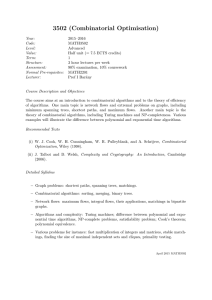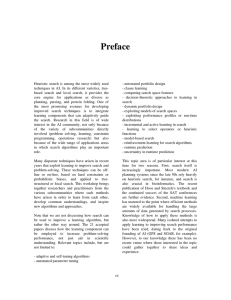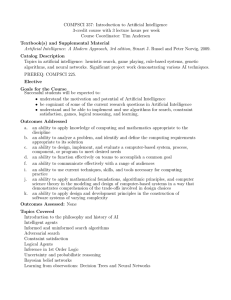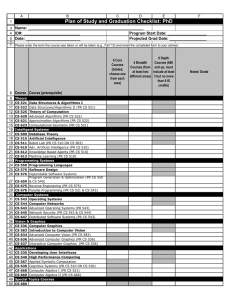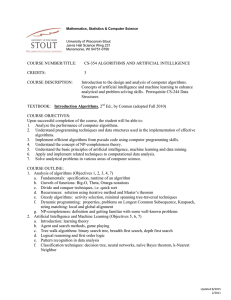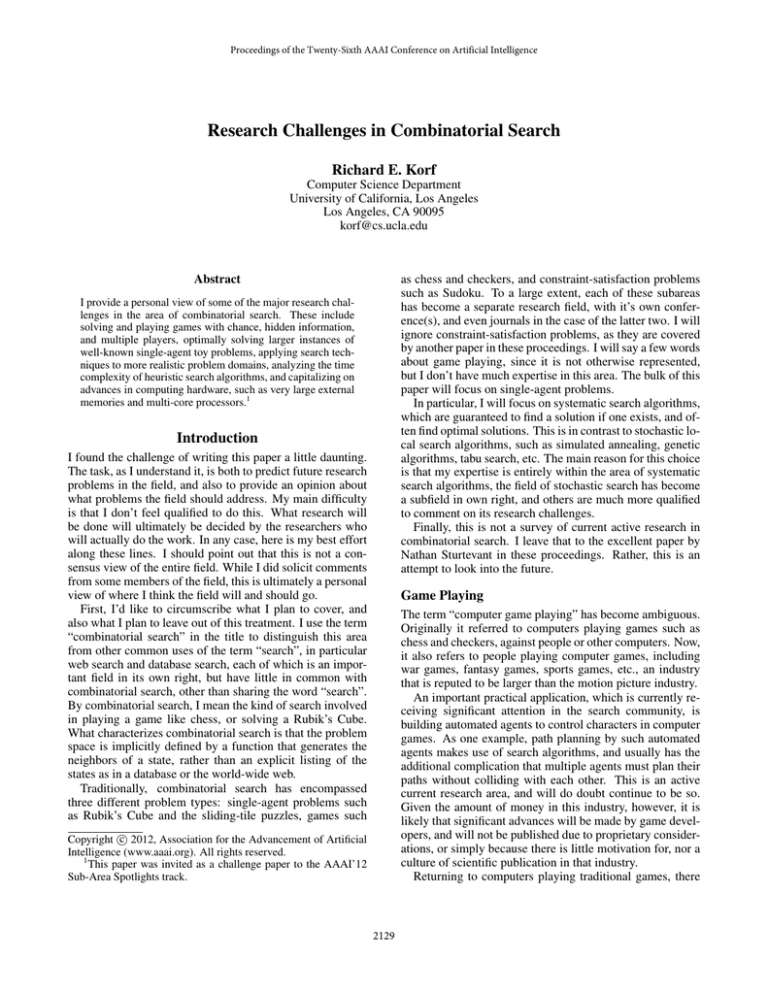
Proceedings of the Twenty-Sixth AAAI Conference on Artificial Intelligence
Research Challenges in Combinatorial Search
Richard E. Korf
Computer Science Department
University of California, Los Angeles
Los Angeles, CA 90095
korf@cs.ucla.edu
Abstract
as chess and checkers, and constraint-satisfaction problems
such as Sudoku. To a large extent, each of these subareas
has become a separate research field, with it’s own conference(s), and even journals in the case of the latter two. I will
ignore constraint-satisfaction problems, as they are covered
by another paper in these proceedings. I will say a few words
about game playing, since it is not otherwise represented,
but I don’t have much expertise in this area. The bulk of this
paper will focus on single-agent problems.
In particular, I will focus on systematic search algorithms,
which are guaranteed to find a solution if one exists, and often find optimal solutions. This is in contrast to stochastic local search algorithms, such as simulated annealing, genetic
algorithms, tabu search, etc. The main reason for this choice
is that my expertise is entirely within the area of systematic
search algorithms, the field of stochastic search has become
a subfield in own right, and others are much more qualified
to comment on its research challenges.
Finally, this is not a survey of current active research in
combinatorial search. I leave that to the excellent paper by
Nathan Sturtevant in these proceedings. Rather, this is an
attempt to look into the future.
I provide a personal view of some of the major research challenges in the area of combinatorial search. These include
solving and playing games with chance, hidden information,
and multiple players, optimally solving larger instances of
well-known single-agent toy problems, applying search techniques to more realistic problem domains, analyzing the time
complexity of heuristic search algorithms, and capitalizing on
advances in computing hardware, such as very large external
memories and multi-core processors.1
Introduction
I found the challenge of writing this paper a little daunting.
The task, as I understand it, is both to predict future research
problems in the field, and also to provide an opinion about
what problems the field should address. My main difficulty
is that I don’t feel qualified to do this. What research will
be done will ultimately be decided by the researchers who
will actually do the work. In any case, here is my best effort
along these lines. I should point out that this is not a consensus view of the entire field. While I did solicit comments
from some members of the field, this is ultimately a personal
view of where I think the field will and should go.
First, I’d like to circumscribe what I plan to cover, and
also what I plan to leave out of this treatment. I use the term
“combinatorial search” in the title to distinguish this area
from other common uses of the term “search”, in particular
web search and database search, each of which is an important field in its own right, but have little in common with
combinatorial search, other than sharing the word “search”.
By combinatorial search, I mean the kind of search involved
in playing a game like chess, or solving a Rubik’s Cube.
What characterizes combinatorial search is that the problem
space is implicitly defined by a function that generates the
neighbors of a state, rather than an explicit listing of the
states as in a database or the world-wide web.
Traditionally, combinatorial search has encompassed
three different problem types: single-agent problems such
as Rubik’s Cube and the sliding-tile puzzles, games such
Game Playing
The term “computer game playing” has become ambiguous.
Originally it referred to computers playing games such as
chess and checkers, against people or other computers. Now,
it also refers to people playing computer games, including
war games, fantasy games, sports games, etc., an industry
that is reputed to be larger than the motion picture industry.
An important practical application, which is currently receiving significant attention in the search community, is
building automated agents to control characters in computer
games. As one example, path planning by such automated
agents makes use of search algorithms, and usually has the
additional complication that multiple agents must plan their
paths without colliding with each other. This is an active
current research area, and will do doubt continue to be so.
Given the amount of money in this industry, however, it is
likely that significant advances will be made by game developers, and will not be published due to proprietary considerations, or simply because there is little motivation for, nor a
culture of scientific publication in that industry.
Returning to computers playing traditional games, there
c 2012, Association for the Advancement of Artificial
Copyright Intelligence (www.aaai.org). All rights reserved.
1
This paper was invited as a challenge paper to the AAAI’12
Sub-Area Spotlights track.
2129
The first challenge is to find any solution at all. For some
problems, such as the Pancake Problem, this is trivial. For
others, such as Rubik’s Cube, it is far from trivial, as least
for humans. For all of these problems, however, there exist
deterministic algorithms that will efficiently generate suboptimal solutions to arbitrary problem instances.
The second and most common challenge is to find optimal
or shortest solutions to random problem instances. This is
generally accomplished using systematic search algorithms
such as A* (Hart, Nilsson, and Raphael 1968) or IDA* (Korf
1985) with admissible or lower-bound heuristics. Since all
these problems come in different sizes, the obvious research
challenge is to find optimal solutions to larger instances than
can currently be solved optimally. For the sliding-tile puzzles, currently the largest size problem for which random
instances can be solved optimally is the 5 × 5 Twenty-Four
Puzzle. For Rubik’s Cube, the classic 3 × 3 × 3 is the state
of the art. The next research challenge is to optimally solve
random instances of the 6 × 6 Thirty-Five Puzzle, or the
4 × 4 × 4 Rubik’s Cube. Since these represent enormous increases in the sizes of the corresponding search spaces, for
the sliding-tile puzzles at least one can consider intermediate
problems such as the 5 × 6 Twenty-Nine Puzzle.
Looking back, solving a significantly larger instance than
the previous state of the art has generally required a new
idea, rather than incremental improvements to existing techniques. For example, moving from optimal solutions to the
3 × 3 Eight Puzzle to the 4 × 4 Fifteen Puzzle required
overcoming the memory limitation of the A* algorithm with
IDA*. Moving from optimal solutions to the 2 × 2 × 2 Rubik’s Cube to the 3 × 3 × 3 Rubik’s Cube (Korf 1997) required the development of pattern database heuristics, which
precompute and store in memory large tables of heuristic
values for subparts of the problem in question (Culberson
and Schaeffer 1998). Moving from the Fifteen Puzzle to
the Twenty-Four Puzzle required the development of additive pattern databases (Korf and Felner 2002), which allow
heuristic values for different parts of the puzzle to be added
together while preserving the lower-bound property required
for optimal solutions. For a recent example, the discovery of
a better admissible heuristic for the Pancake Problem led to
a dramatic increase in the size of problems that can be solved
optimally (Helmert 2010).
The third and next harder challenge is to determine the
worst-case optimal solution length for any instance of a
given problem. For example, the hardest Fifteen Puzzle instance requires 80 moves to solve (Brungger et al. 1999).
Similarly, a problem that was open for over 35 years and
only recently solved was to determine the worst-case optimal solution for an instance of the 3 × 3 × 3 Rubik’s Cube.
The answer is 20 moves, assuming that a 180-degree twist
is counted as a single move (Rokicki et al. 2010). The obvious challenge is to determine these values for larger versions of these problems, such as the Twenty-Four Puzzle or
the 4 × 4 × 4 Rubik’s Cube.
Finally, there is the challenge of exhaustively searching
the entire problem space of a given problem. One compact
way to present the output of such a search is to list the number of unique states at each depth from a designated initial
are two primary research challenges. The first is building
programs to beat the best humans at various games, and the
second is “solving” a game, which means to determine an
optimal strategy for playing the game, and the win, loss, or
draw value of a game given optimal play by all players.
Building a program that can defeat the best humans is
the easier of these two tasks. The first non-trivial games
to be addressed, chess and checkers, are two-player perfectinformation games, and the signature achievement of this effort was the defeat of Gary Kasparov by the Deep Blue machine in 1997 (Campbell, Hoane, and Hsu 2002). Currently,
the most high-profile challenge in this area is the game of
Go, a two-player perfect-information game, but one where
the best computers are not yet competitive with the best people. As a general observation, computers tend to play better
relative to people in games with smaller branching factors,
where search is most effective.
Current and future challenges include games with chance
elements, such as backgammon, games with hidden information, including card games such as bridge and poker, and
games with more than two players, particularly those that
involve coalitions among groups of players. The challenge
is simple to state: pick a game, and build a program that is
better than the best humans.
Solving a game is even more difficult than beating the
best humans, since it requires computing a perfect strategy.
The most complex game solved to date is checkers (Schaeffer et al. 2007). It’s a draw if both players play optimally.
Again, the challenge is simple to state: pick a game that
hasn’t been solved, and solve it. For the near future, these
efforts are likely to focus on two-player perfect-information
games. For example, solving chess is an obvious challenge.
We now turn our attention to the main focus of this paper,
which is single-agent problems.
Solving Larger Toy Problems
Much research in this area has used classical toy problems
such as the 4×4 sliding-tile Fifteen Puzzle, or Rubik’s Cube
as problem domains. Other more recently popular problems
include permutation puzzles such as Top-Spin or the Pancake Problem, or the 4-peg Towers of Hanoi problem. A
commercially available version of Top-Spin consists of a
circular ring of twenty distinct tokens, and a turnstile that
can reverse the order of any four consecutive tokens in the
ring. The pancake problem (Dweighter 1975) consists of a
stack of n pancakes, all of different sizes, and a “spatula”
that flips or reverses the order of the top k pancakes, the
goal being to sort the pancakes in order of size. The 4-peg
Towers of Hanoi problem has the same rules as the classical
3-peg problem, but adds one additional peg. It’s an interesting search problem because the optimal solution to this
problem is not known with certainty.
What characterizes all these problems is that for a given
size, there is a single common search space. What distinguishes one instance from another is simply the choice of
initial and goal states. With any such problem, there are
at least four different research challenges, listed here in increasing order of difficulty.
2130
genome of a human and that of a mouse, one would like to
find regions of similarity between the two. The sequences
are the strings of base pairs in their DNA, and the alignment process finds regions of similarity. Optimal pairwise
alignment can be modelled as finding a lowest-cost cornerto-corner path in a two-dimensional grid, where each axis
is labeled with the letters of one of the sequences, using a
function that assigns a cost to each edge. This is a classic
search problem. Its complexity is quadratic in the lengths of
the sequences, but the sequences can be up to three billion
base pairs long. Similarly, simultaneous alignment of three
sequences can be modelled as finding a lowest-cost corner
to corner path in a three-dimensional grid.
In addition to solving problems with important practical
applications, moving beyond a small set of toy problems has
another important advantage. When a single problem receives a lot of attention from researchers, further significant
advances in the state-of-the-art become more difficult. This
is true of both toy problems, such as the sliding-tile puzzles, and well-studied NP-complete problems, such as the
travelling salesman problem. New problems that have not
received extensive study often have new features that give
rise to new techniques and algorithms, providing more opportunities for researchers to advance the state-of-the-art.
state. This was accomplished for the Eight Puzzle in the
1960s (Schofield 1967), and more recently for the Fifteen
Puzzle (Korf and Schultze 2005). Performing such an exhaustive search for Rubik’s Cube is perhaps the last remaining search challenge associated with the 3 × 3 × 3 cube.
Beyond Toy Problems
Perhaps the sharpest criticism leveled at the area of combinatorial search is that many of the problem domains used
are toy problems. I’m as guilty as anyone in this regard, but
I’ll argue here that it would behoove us to move beyond toy
problems towards more realistic applications. I’ll begin by
examining the argument in favor of toy problems.
First, I want to make it clear that by “toy” problem I don’t
mean a trivial problem. Rubik’s Cube has a problem space
with over 1019 states, and the Twenty-Four Puzzle has over
1024 states. Finding optimal solutions, the worst-case optimal solution length, or performing an exhaustive search of
such problems spaces are far from trivial, to say the least.
I use the term “toy” here in the sense that a Rubik’s Cube,
for example, is literally a toy. Even to buy a chess set, one
would probably go to a toy store.
There are several arguments for working on toy problems.
One is that they are simple to describe, and easy to implement. In addition, these properties often motivate other researchers to work on the same problems, greatly facilitating
the comparison of results. Finally, techniques developed on
toy problems are often transferable to real-world problems.
While all these arguments have merit, the last is perhaps
the most suspect. If the goal is to develop techniques that
apply to real-world problems, then why not work on those
problems directly? The usual response is that they are much
more complex to describe and implement. I believe, however, that we can preserve the main advantages of toy problems by working on abstractions of real-world problems.
Many NP-hard problems, for example, are very simple to
state, and directly model real-world problems. Furthermore,
combinatorial search techniques are required to find optimal
solutions to NP-hard problems. A concrete example from
my own work is number partitioning (Korf 2011). Given a
set of integers, divide them into a fixed number of subsets, so
that the largest subset sum is minimized. Number partitioning directly models the problem of multi-processor scheduling, where each of a set of jobs with different durations must
be assigned to one of a set of identical processors or cores,
so that all jobs are completed in the shortest possible time.
Implementing a simple search algorithm for number partitioning is much simpler than implementing an algorithm for
Rubik’s Cube. There are hundreds of simple NP-hard problems, many of which were invented as abstractions of realworld problems, and many of them have received little attention from researchers. Thus, we can have the simplicity
advantages of toy problems, while solving problems that directly model real-world applications.
In addition to NP-hard problems, there are other search
problems that are computationally challenging, even if their
complexities are polynomial. One such problem, which has
been as a test domain for search algorithms, is sequence
alignment in computational biology. For example, given the
Optimal versus Suboptimal Solutions
I have focussed above almost exclusively on finding optimal solutions to combinatorial problems. For large instances
of NP-hard problems, this is not feasible in practice. As a
result, many researchers have switched their focus to algorithms that find suboptimal solutions. I have not done this,
for several reasons.
The first is that it is much more difficult to compare different algorithms that find suboptimal solutions. The reason
is that there are two figures of merit for such algorithms, the
solution quality and the running time. In order for one suboptimal algorithm to dominate another, it must find better
solutions for all different running times. This rarely occurs
in practice. Rather, one algorithm often will find better solutions for small running times, but other algorithms will find
better solutions given longer running times. With optimal
algorithms, we only have to compare the running times to
find optimal solutions.
In addition, for most problems, there is another option for
dealing with instances that are too large to solve optimally in
practice, which is an anytime optimal algorithm. An anytime
optimal algorithm returns a solution to a problem almost immediately, and as it continues to run it finds better solutions,
until it generates, and then eventually verifies an optimal solution. Given any deadline to solve a problem, an anytime
algorithm can be run up until the deadline, with the best solution found at that point returned. These algorithms can be
compared against each other by the time they take to verify
optimal solutions on smaller problem instances. In addition,
many of these algorithms allow guarantees on the quality of
the solutions generated, relative to optimal solutions. For
example, weighted-A* allows one to bound solution quality
to within an arbitrary constant of optimal, but the smaller the
constant, the larger the running time (Pohl 1973).
2131
Analyzing the Running Time of
Heuristic Search Algorithms
random disk accesses. Two approaches to this problem include delayed duplicate detection (Korf 2008) and structured
duplicate detection (Zhou and Hansen 2004).
Looking forward, the biggest recent change in the evolution of computer hardware has been a levelling off of
clock speeds, accompanied by an increase in the number
of CPU cores on a chip. As with the rest of computer science, research in combinatorial search will have to figure
out how to best make use of such parallel processing. In
a sense, combinatorial search is well-suited to parallel processing, since search algorithms are characterized by relatively small atomic computations, such as a node generation
or expansion, repeated many times in the course of a search.
This property should make search easy to parallelize. On
the other hand, parallel processing has been around for a
long time, and some canonical algorithms, such as minimax
search with alpha-beta pruning, have been notoriously difficult to parallelize.
An important research goal in any area of computer science
is to be able to predict the running time of algorithms. For
brute-force search algorithms, this is often straightforward,
since the running time is proportional to the number of node
generations, and it is often easy to calculate how many states
there are in a complete problem space. As algorithms become more efficient, however, they become more complex,
and it becomes more difficult to analyze their running times.
For example, depth-first branch-and-bound is a ubiquitous
search algorithm, yet it is very difficult to predict its running
time. One reason is that the amount of pruning depends on
the sequence in which solutions are found. For example, the
maximum amount of pruning only occurs once an optimal
solution is found, and when that will occur during the search
is very difficult to determine in advance.
As another example, the running time of any heuristic
search depends on the quality of the heuristic function, in
addition to the algorithm. This requires a way of characterizing the heuristic function in a way that allows predicting
the performance of a search algorithm using that heuristic.
Early work in this area (Pearl 1984) was focussed on
asymptotic complexity based on abstract models of search
spaces, and high-level measures of heuristic accuracy. Unfortunately, those asymptotic results couldn’t accurately predict the actual numbers of nodes generated on real problems
with real heuristics.
More recently, there has been some success predicting the
actual performance of IDA* on problems such as the slidingtile puzzles and Rubik’s Cube (Korf, Reid, and Edelkamp
2001). This remains an active area of research (Zahavi et al.
2010), but predicting the performance of most algorithms,
using most heuristics, on most problems remains an important research challenge.
Summary
I have provided a personal view of future research challenges in the area of single-agent combinatorial problems,
and to a limited extent computer games. In the latter area
these include automated characters in computer gaming, and
solving and playing human games with chance elements,
hidden information, and multiple players. In the former area
the research challenges include finding optimal solutions to
larger versions of classical toy problems, solving combinatorial problems that model real-world applications, analyzing
the time complexity of search algorithms, and capitalizing
on new hardware technologies.
Acknowledgments
Thanks to Carlos Linares Lopez, Wheeler Ruml, and Ariel
Felner for suggesting research challenges for this paper.
Thanks to Victoria Cortessis for helpful comments on a draft
of this paper.
Capitalizing on New Hardware Capabilities
In addition to new problems, and new ideas for old problems, another generator of research in combinatorial search
is new hardware technologies, or significant changes in the
scale of existing technologies. Nobody would doubt that
dramatic increases in processor speeds over the last 60 years
has played a critical role in some of the biggest success stories in combinatorial search. Similarly, the dramatic increase
in memory capacities has made pattern database heuristics
practical and effective for a wide variety of problems.
A more recent example has been the explosion in the capacity of magnetic disk storage over the past decade. Traditionally, disk storage has been used primarily for file storage, rather than as temporary storage for computation. Many
combinatorial search algorithms are limited by the available
storage, since they save most of the nodes that they generate, in order to detect duplicate node generations and prevent
multiple reexpansions of the same states. Recently search
algorithms have been implemented that store their nodes on
magnetic disk rather than main memory, in order to take advantage of their much larger capacity. The main research
challenge has been to deal with the very long latencies of
References
Brungger, A.; Marzetta, A.; Fukuda, K.; and Nievergelt, J.
1999. The parallel search bench ZRAM and its applications.
Annals of Operations Research 90:45–63.
Campbell, M.; Hoane, A.; and Hsu, F. 2002. Deep blue.
Artificial Intelligence 134(1-2):57–83.
Culberson, J., and Schaeffer, J. 1998. Pattern databases.
Computational Intelligence 14(3):318–334.
Dweighter, H. 1975. Elementary problem e2569. American
Mathematical Monthly 82(10):1010.
Hart, P. E.; Nilsson, N. J.; and Raphael, B. 1968. A formal basis for the heuristic determination of minimum cost
paths. IEEE Transactions on Systems Science and Cybernetics SSC-4(2):100–107.
Helmert, M. 2010. Landmark heuristics for the pancake
problem. In Proceedings of the Symposium on Combinatorial Search (SOCS-10).
Korf, R. E., and Felner, A. 2002. Disjoint pattern database
heuristics. Artificial Intelligence 134(1-2):9–22.
2132
heuristic competence, genuine dynamic weighting and computational issues in heuristic problem solving. In Proceedings of the Third International Joint Conference of Artificial
Intelligence (IJCAI-73), 12–17.
Rokicki, T.; Kociemba, H.; Davidson, M.; and Dethridge,
J. 2010. Brute-forcing rubik’s cube: God’s number is 20.
http://tomas.rokicki.com/rubik20.pdf.
Schaeffer, J.; Culberson, J.; Treloar, N.; Knight, B.; Lu,
P.; and Szafron, D. 2007. Checkers is solved. Science
317(5844):1518–1522.
Schofield, P. 1967. Complete solution of the eight puzzle.
In Meltzer, B., and Michie, D., eds., Machine Intelligence 3.
New York: American Elsevier. 125–133.
Zahavi, U.; Felner, A.; Burch, N.; and Holte, R. C. 2010.
Predicting the performance of ida* using conditional dependencies. Journal of Artificial Intelligence Research (JAIR)
37:41–83.
Zhou, R., and Hansen, E. A. 2004. Structured duplicate detection in external-memory graph search. In Proceedings
of the 19th National Conference on Artificial Intelligence
(AAAI-2004), 683–688.
Korf, R. E., and Schultze, P. 2005. Large-scale, parallel
breadth-first search. In Proceedings of the 20th National
Conference on Artificial Intelligence (AAAI-2005), 1380–
1385.
Korf, R. E.; Reid, M.; and Edelkamp, S. 2001. Time complexity of Iterative-Deepening-A*. Artificial Intelligence
129(1-2):199–218.
Korf, R. E. 1985. Depth-first iterative-deepening: An optimal admissible tree search. Artificial Intelligence 27(1):97–
109.
Korf, R. E. 1997. Finding optimal solutions to Rubik’s cube
using pattern databases. In Proceedings of the 14th National
Conference on Artificial Intelligence (AAAI-97), 700–705.
Korf, R. E. 2008. Linear-time disk-based implicit graph
search. Journal of the Association for Computing Machinery
55(6):26–1 to 26–40.
Korf, R. E. 2011. A hybrid recursive multi-way number partitioning algorithm. In Proceeding of the 22nd International
Joint Conference on Artificial Intelligence ((IJCAI-11), 591–
596.
Pearl, J. 1984. Heuristics. Reading, MA: Addison-Wesley.
Pohl, I. 1973. The avoidance of (relative) catastrophe,
2133



